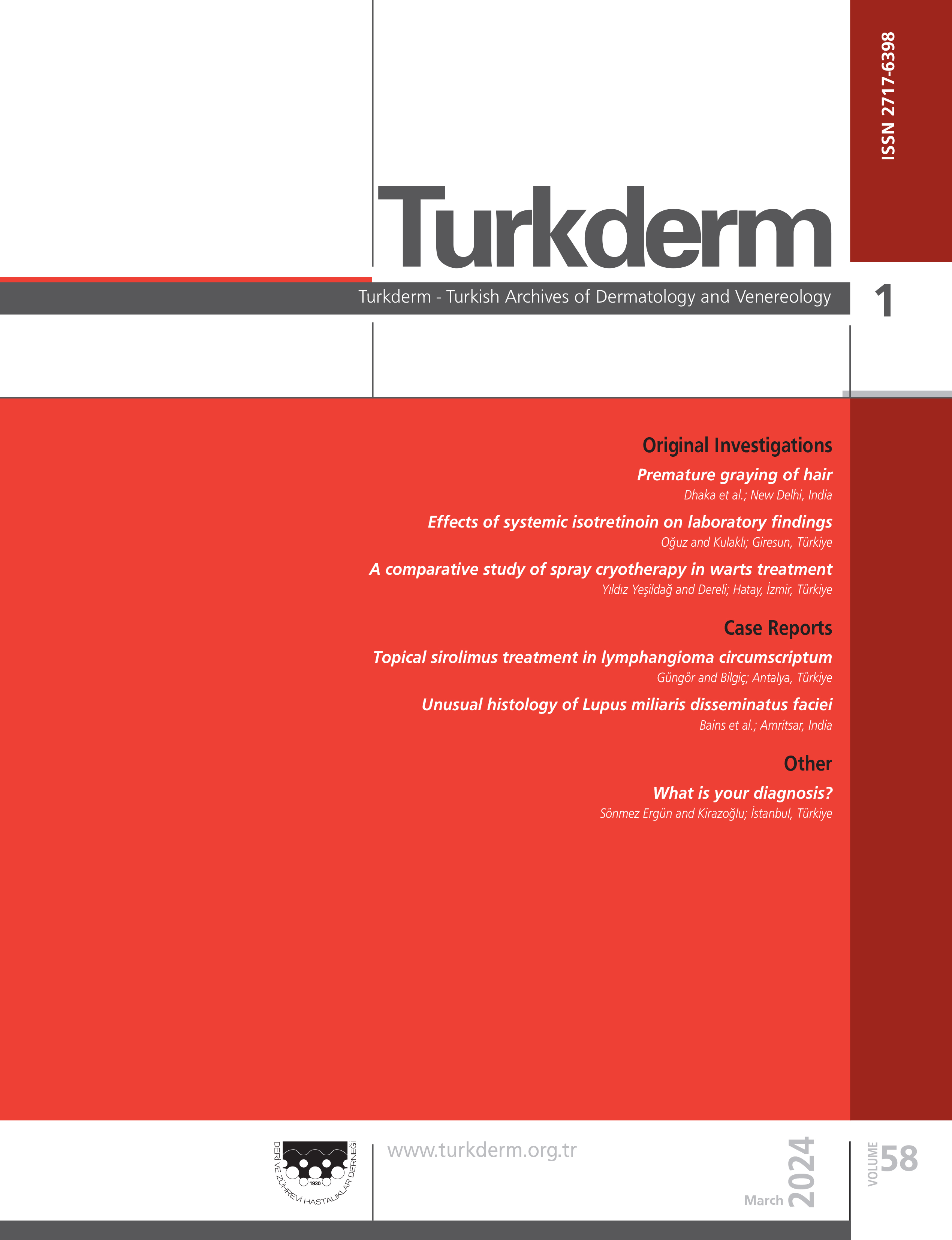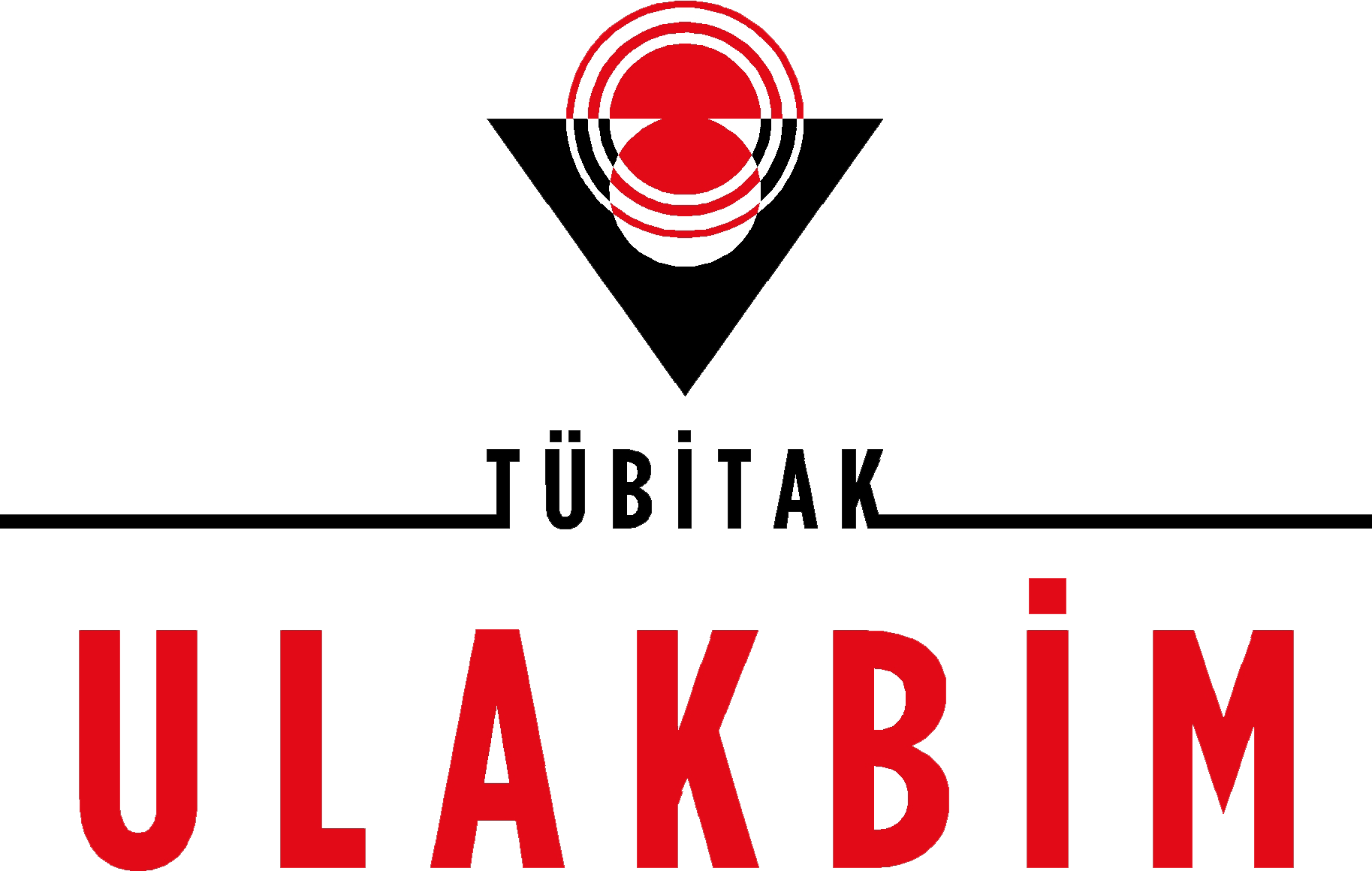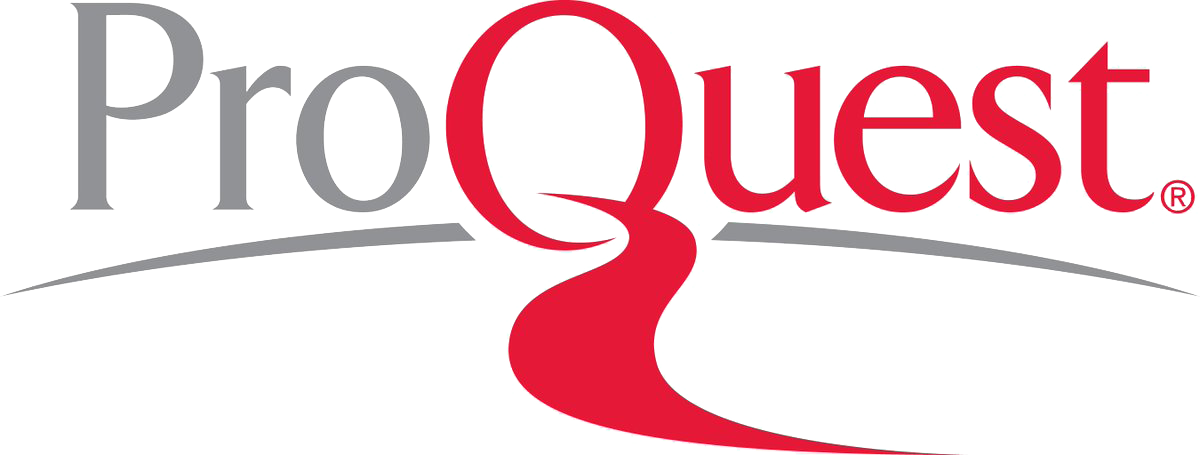Volume: 37 Issue: 1 - 2003
| EDITORIAL | |
| 1. | Pediatrik dermatoloji eğitimi Ümit UkşalPage 15 Abstract | |
| REVIEW ARTICLE | |
| 2. | Quality of life in dermatology Esen Acıöz, Gonca Gökdemir, Adem Köşlü Pages 16 - 23 Deri hastalığı; kişinin görünüşünü dolayısıyla yaşamını özellikle sosyal ve emosyonel durumunu diğer hastalık gruplarından daha fazla etkiler. Bu etkiler hastalığın şiddetinin ölçüldüğü parametrelere yansımayan; psikolojik stres, utanma, fiziksel rahatsızlık ve günlük yaşamdaki etkilenim gibi pekçok şekilde ortaya çıkmaktadır. Yaşam kalitesi yöntemleri; hastalığın kişinin iyilik hali üzerine etkilerini ölçmek amacıyla geliştirilmiştir. Dermatolojide yaşam kalitesini saptamaya yönelik geliştirilmiş yöntemler sıklıkla belli alanlarda kullanılır ki bunlar; mediko-ekonomik değerlendirme, klinik araştırma ve değerlendirme çalışmaları, hastaların gereksinimlerine yanıt verme ve dermatoloji kliniklerini denetlemeye yöneliktir. Farklı hastalık gruplarının yaşam kalitesini saptamak amacıyla geliştirilmiş çok sayıda yöntem olmasına rağmen ( örneğin SF-36, Hastalık Etki Profili),ki bunlar genel sağlığa ait testlerdir, deri hastalıkları ile ilişkili olduğu bilinen çarpıcı faktörlerin büyük kısmını ve medikal tedaviye cevabını içermemektedir.Klinik araştırmacılar, dermatoloji kliniklerinde ve gözlemsel araştırmalarda kullanabilecekleri basit ve ihtiyaca cevap verecek dermatolojiye ve hastalığa spesifik yöntemler geliştirmişlerdir. Dermatolojiye özgü testler içersinde en önemli ve yaygın olarak kullanılanı Dermatolojik Yaşam Kalite İndeksi (DLQI= Dermatology Life Quality Index) dir. DYKİ; basit, kısa, anlaşılır bir test olup, yaşam kalite yöntemleri içerisinde ülkemizde en sık kullanılanıdır. Skin diseases affect the patientsÕ lookings, social life and emotional situation. These effects are psychological stress, embrassment and physical disability. All these effects are not correlated with the severity of the disease. The methods for life quality were developed to measure the impact of any given disease on state of well-being of the patient. Methods of measuring quality of life in dermatology are used for medical-economic assesment, clinical research, definition of the patientsÕ needs and supervision of the dermatology clinics. Many methods for measuring the quality of life in various diseases have been designated. (For example; SF-36, Sickness Impact Profile etc.) However, these forms do not evaluate all dermatologic patients adequately. Therefore, dermatology spesific questionnaires have been developed. Being simple and clear, Dermatology Life Quality Index (DLQI) is the most frequently used method all over the world as well as in our country. |
| ORIGINAL INVESTIGATION | |
| 3. | Subclinical joint involvement in psoriasis: MRI and scintigraphic details Göker Öz, Bilal Doğan, Yavuz Narin, Emir Şilit, Yavuz Harmanyeri Pages 24 - 27 Kemik sintigrafisi (KS) ve manyetik rezonans görüntüleme (MRG) tetkikleri psoriatik artritin tanısında son yıllarda sık kullanılmaktadır. KS ve MRG'ın el ve el ekleminin subklinik psoriatik artrit (PsA) tanısındaki değerini belirleyebilmek için Mayıs 2000-Mayıs 2002 tarihleri arasında psoriasis tanısı konulan ve hiçbir eklem şikayetinin olmadığı bir romatoloji uzmanının muayenesi ve her iki el ve el bileği X-ray grafileri ile teyit edilen 25 erkek hasta (18-26 yaş, ort: 21) yatırılarak incelendi. Hastaların PASI skorları kaydedildikten sonra, her iki el ve el bileği MRG incelemesi ve sonra da her iki el bileği ve tüm vücut KS'leri yapıldı. MRG incelemesi sonucu 4 hastada patolojik tutulum PsA ile uyumlu bulunurken, sintigrafide ise patolojik sonuç elde edilen 9 hastanın ancak 3 tanesi MRG ile PsA lehine doğrulandı. Diğer 6 hastadaki patolojik bulgular post-travmatik osteoblastik aktivite olarak değerlendirildi. PASI skorları ile KS ve MRG sonuçları arasındaki ilişki istatistiksel olarak anlamlı değildi (Mann-Whitney U, P>0,05). Ayrıca MRG ve KS sonuçları arasındaki ilişki de istatistiksel olarak anlamlı değildi (Fischer's Exact Test, P=0,116). MRG ile KS sonuçları, erken tanıda nispeten daha duyarlı olduğu bildirilen MRG esas alınarak karşılaştırıldığında, sintigrafinin sensitivitesi % 75, spesifitesi ise % 71 olarak bulunmuştur. Dolayısı ile KS'nin, PsA riskli hastalarda daha ucuz maliyeti ve ihmal edilebilir radyoaktivitesi nedeniyle semptomsuz ve konvansiyonel radyoloji ile görüntülenemeyen artiküler lezyonların taranmasında öncelikle kullanılabileceği düşünüldü. Background and design: Three different radiological methods which are X-ray, bone scintigraphy (BS) and magnetic resonance imaging (MRI) are being widely used to diagnose psoriatic artritis. We aimed to compare success rates of BS and MRI for evaluating the frequency of subclinical hand joint involvement in psoriasis and to determine of which should be used preferentially for screening purposes. Materials and methods: 25 male patients (ages between 18-26 years, mean: 21) who had no complaints of artritis subjectively and with phyisical and X-ray examination, included in the study. BS and MRI of both hands and wrists were performed and in addition, whole body scintigraphy of all patients were also performed. Results: The number of patients with MRI findings supporting psoriatic artritis (PsA) were four. Only three out of 9 patients who had pathological results with scintigraphy, were confirmed as PsA by MRI. They were not statistically significant (P>0,05) when we compare the results of MRI and scintigraphy with PASI scores by means of Mann-Whitney U Test. Besides, the analysis of results of MRI and BS (FischerÕs Exact Test) was not statistically significant. The specificity and sensitivity rates of scintigraphy were 71% and 75% respectively, when we take the MRI as main subject. Conclusion: We found that BS and MRI can be used for diagnosis of early PsA. Therefore BS can be used for screening purpose in patients with probable PsA because of its negligable radioactivity and relative cheapness. |
| 4. | Psychiatric comorbiditiy in recurrent aphthous stomatitis and its relationship with depression Mustafa Yıldız, Gaye Ünal Pages 28 - 31 Yineleyen aftöz stomatit (YAS) oral mukozada yineleyen ülserlerle ve ağrıyla giden kronik yangısal bir hastalıktır. Etyolojisinde immün bozuklukların rol oynadığı ileri sürülmektedir. Yineleyen perioral herpes lezyonlarıyla ilişkili olarak immun ve nöroendokrin belirteçlerle stres ve duygusal durumlar arasında ilişki vardır. Major depresif bozuklukta da (MDB) immün sistemde bozulmalara sık rastlanmaktadır. Kocaeli Üniversitesi Tıp Fakültesi Hastanesi Dermatoloji polikliniğinde YAS tanısı alan 30 hasta ve Psikiyatri polikliniğinde MDB tanısı alan 30 hasta çalışmaya alındı. YAS hastaları bir psikiyatrist tarafından SCID-I kullanılarak ruhsal bozukluklar açısından, MDB hastaları da bir dermatolog tarafından dermatolojik hastalıklar açısından incelendi. YAS hastalarında yaşam boyu en sık karşılaşılan psikiyatrik tanı %40 oranında depresif bozukluktu. Aftöz lezyonların alevlenmesi ile psikososyal stresler arasında belirgin bir ilişki saptanmadı. YAS hastalarının sadece %37'sinde alevlenmeler ile stresler arasında doğrudan bir ilişki saptandı. MDB hastalarında komorbid olarak en sık herpes simpleks infeksiyonu (%67), ikinci sıklıkta da YAS (%50) saptandı. Birlikte görülme oranı yüksek olan YAS ve MDB arasında immün düzensizliğin yer aldığı bir ilişki olduğu ileri sürülebilir. Background: Recurrent aphthous stomatitis (RAS) is a chronic inflammatory disease characterized by painful, recurring ulcerations of the oral mucosa. Immune disturbances have been speculated about in the aetiology of recurrent aphthous stomatitis. There is a relationship between stress, mood states, and immune and neuroendocrine markers associated with the recurrence of perioral herpes lesions. Major depressive disorder (MDD) is also associated with an inflammatory immune response. Method: Patients diagnosed as recurrent aphthous stomatitis (n: 30) in the Department of Dermatology, and patients with major depressive disorder (n: 30) according to DSM-IV criteria in the outpatient clinic of Psychiatry of the Medical Faculty of Kocaeli University have been included in this study. RAS patients have been evaluated by the psychiatrist using SCID I, and patients with MDD have been examined by the dermatologist. Results: The most prevalent lifetime psychiatric disorder in RAS patients was depressive disorder at the rate of 40%. The relationship between exacerbations of aphthous lesions and psychosocial stressors was not prominent. Only 37% of the RAS patients showed a direct correlation between such exacerbations and the stressors. MDD patients were concurrently diagnosed as herpes simplex infections and RAS (67% and 50% respectively). Conclusion: The high rate of concordance between RAS and MDD can lead to the conclusion that there is a relationship between two disorders in the basis of immune disturbances. |
| 5. | Cutaneous tuberculosis: a 18 - year retrospective evaluation İdil Ünal, Fezal Özdemir, Ali Can Kazandı, Sibel Alper, Figen Yazkan Pages 32 - 36 Deri tüberkülozu insidansının ve prevalansının tüm dünyada çarpıcı olarak azaldığı göze çarpmakla beraber, HIV enfeksiyonunun sık izlendiği bölgelerde sıklığında artış gözlenmektedir. Gelişmekte olan ülkelerde ise deri tüberkülozu deri enfeksiyonları arasındaki önemini halen korumaktadır. Bu çalışma Ege Üniversitesi Tıp Fakültesi Dermatoji Kliniğinde deri tüberkülozunun epidemiyolojisini, klinik ve histopatolojik özelliklerini saptamak amacıyla planlanmıştır. Çalışmaya 1985-2002 yılları arasında Ege Üniversitesi Tıp Fakültesi Dermatoloji Anabilim Dalı'nda tanı konan deri tüberkülozu olguları alındı. Saptanan 93 olgunun epidemiyolojik, klinik özellikleri değerlendirildi. Biyopsi kesitleri incelenerek histopatolojik özellikleri tekrar değerlendirildi. Sonuç olarak Lupus vulgaris en sık izlenen (%74) deri tüberkülozu olgusu olarak bulundu. Bunu %13 lük oranlarıyla skrofuloderma ve tüberkülozis verrükoza kutis izledi. Son yıllardaki çalışmalarla kıyaslanınca tüberkülozis verrükoza kutis olgularının sayıca artışı dikkat çekiciydi. Yerleşim yeri lupus vulgariste en sık baş-boyun bölgesi (% 72.4) olarak gözlenmişken, skrofulodermada boyun bölgesi (%66.6) lokalizasyonu, tüberkülozis verrükoza kutis lezyonlarında ekstremite lokalizasyonu (%100) belirgindi. Son yıllarda insidansında düşme saptansa da, deri tüberkulozunun Türkiye'de halen önemini koruyan bir sıklığa sahip olduğu gözlenmektedir. Background and Design: While the incidence and prevalence of cutaneous tuberculosis dropped markedly around the world, it has re-emerged in areas with a high incidence of HIV infection. Cutaneous tuberculosis still keeps its importance among other skin infections in developing countries. This study was conducted to determine the epidemiology, clinical and histopathological properties of cutaneous tuberculosis in Dermatology Department of Ege University Medical Faculty. Materials and Methods: The cases of cutaneous tuberculosis which was diagnosed in Dermatology Department of Ege University Medical faculty were studied retrospectively. 93 cases of cutaneous tuberculosis were investigated epidemiologically, clinically and histopathologically. The biopsy specimens were examined and the histopathological features were reevaluated. Results: 69 (%74) cases of lupus vulgaris, 12(%13) cases of scrofuloderma, 12(%13) cases of tuberculosis verrucosa cutis were observed. The increase in the incidence of tuberculosis verrucosa cutis was noticed comparing with recent epidemiological studies. Lupus vulgaris lesions have been found to be localized mostly on head and neck region (% 72.4), scrofuloderma lesions on the neck (%66.6) and tuberculosis verrucosa cutis lesions on extremities (%100). Conclusions: Although number of skin tuberculosis have been observed to decrease by years it has still an important incidence in Turkey. In our study, lupus vulgaris was the most common form of cutaneous tuberculosis followed by the equal proportion of scrofuloderma and tuberculosis verrucosa cutis. |
| 6. | The clinical course of Behçet's diseases in pregnancy Afet Akdağ Köse Pages 37 - 40 50 gebe Behçet Hastası klinik seyir açısından skorlandırılarak gebelik öncesi, gebelik esnası ve gebelik sonrası olmak üzere üç dönemde toplam 15 ay izlendi. Mukokutan lezyonların yine aynı dönemlerdeki artıp azalma oranları incelendi. Veriler Wilcoxon Signed Rank test ile değerlendirildi. Klinik seyirde gebelik öncesi dönem ile I.trimester arasındaki ilişki anlamsız bulunurken (p>0.05), gebelik öncesi - II.trimester (p<0.05), gebelik öncesi - III.trimester (p<0.001) ilişkisi ileri derecede anlamlı bulundu. Mukokutan bulgularda aftlardaki düzelme her trimesterde (p<0.05), genital ülserde (p<0.05), eritema nodozumda (p<0.05), psödofolikülitte (p<0.05) düzelme ise sadece III.trimesterda anlamlı bulundu (compare of two proportion istatistiki yöntem). Sonuç olarak; gebe Behçet hastalarının gebelik dönemindeki seyrine bakarak gebeliğin Behçet Hastalığı üzerinde kötüleştirici bir etkisinin olmadığını, sistem tutulumlarını aktive etmediğini söyleyebiliriz. Gebelikteki bu iyileşmede gebelikte artan progesteron hormonun rolünün olabileceği kanısındayız. Background: A retrospective study among our Behçet's disease clinic patients was planned to evaluate the disease activity during pregnancy. Methods: Fifty pregnant patients enrolled in our Behçet's disease clinic were classified according to their clinical state before pregnancy in three groups as in remission without any lesion, without any change and in activation and were scored. The patients were evaluated both before and after pregnancy. The frequency of mucocutaneous findings before, during and after treatment were recorded. Findings were evaluated with Wilcoxon Signed Rank Test and compare of two proportions methods.Results: The clinical state was significant when compared with before pregnancy and in the first trimester with p>0.05, before pregnancy and in the second trimester with p<0.05 and before pregnancy and in the third trimester with p<0.001. The lesions due to Behçet's disease showed conplete or near to complete improvement in the 2nd and 3 rd trimesters of pregnancy. The mucocutaneous findings before and during pregnancy were compared with the method of the comparison of two proportions. The improvement in oral ulceration was significant in all trimesters (p<0.05) but clinical improvement of genital ulceration, erythema nodosum and pseudofolliculitis was significant only in the third trimester (p<0.05). Conclusion: As a result, considering the clinical state during pregnancy, we can conclude that pregnancy is not associated with aggrevation of BehetÕs disease or activation of systemic involvement. We believe that this clinical improvement may be associated with the increasing progesterone levels during pregnancy. |
| TURKDERM-9860 | |
| 7. | Chronic arsenicism: two cases report Özlem Yerebakan, Oya Ermiş, M. Akif Çiftçioğlu, Ertan Yılmaz, Erdal Başaran Pages 43 - 47 Kronik arsenisizmin deri bulguları arsenik keratozları, pigmentasyon değişiklikleri, Bowen hastalığı, skuamöz hücreli karsinoma ve bazal hücreli karsinoma ile karakterizedir. Burada, kronik arsenisizm tanısı konan 67 yaşında bir erkek hasta ve 65 yaşındaki karısı; bildiğimiz kadarıyla Türk literatüründe ilk kez saptanmaları nedeniyle sunulmaktadır. Olgulara 1mg/kg/gün acitretin tedavisi uygulanmıştır. The cutaneous manifestations of chronic arsenicism include arsenical keratoses, pigmentary anomalies, Bowen's disease, squamous cell carcinoma, and basal cell carcinoma. Here, we describe 67-year-old man and 65 year-old his wife with the diagnosis of chronic arsenicism. To the best of our knowledge, these are the first cases reported in our country. A treatment regimen of acitretin 1 mg/kg per day was given to these patients. |
| 8. | Topical use of GM-CSF for a nonhealing ulcer in a diabetic patient Zeynep Demirçay, Dilek Gün Pages 49 - 51 Diabetik hastalarda yara iyileşmesi yavaşlamaktadır. Yara iyileşmesini uyarabilen bir sitokin olan granülosit makrofaj koloni stimüle edici faktör (GM-CSF), son yıllarda, farklı nedenlere bağlı ülserlerde başarıyla kullanılmaktadır. Bu yazıda, lokal yara bakımına rağmen iyileşme göstermeyen travmatik bacak ülseri, topikal GM-CSF uygulaması sonrasında hızla düzelen diabetik bir hasta sunulmaktadır. Wound healing in diabetic patients is difficult and poor. Granulocyte macrophage colony stimulating factor (GM-CSF) is a cytokine that has been shown to stimulate wound healing. Recently, it has been successfully used for the treatment of ulcers caused by different factors. Here we report a diabetic patient whose traumatic leg ulcer did not show any improvement by local wound care but resolved rapidly after topical granulocyte macrophage colony stimulating factor application. |
| 9. | Persistent edema in a patient with rosacea Kübra Eren Bozdağ, Ahmet Karaman Pages 52 - 53 Rozase tipik olarak yüzün konveks bölümlerini tutan, papül, püstül, eritem ve telenjiektazilerle karakterize kronik inflamatuar bir erüpsiyondur. Rozaseye bağlı lenfödem rozasenin nadir görülen ve görünümü bozan bir varyantıdır. Bu semptom diğer dermatozlarla karıştırılabilir ve klasik rozase sağaltımına dirençli olabilir. Persistan ödem gelişen bir rozase olgusunu sunuyoruz. Rosacea is a chronic inflammatory eruption typically affecting the convexities of the face and characterized by papules, pustules, erythema and telangiectasia. Rosaceous lymphedema is a rare and disfiguring variant of rosacea. This symptom may be confused with other dermatoses and may be refractory to conventional treatments for rosacea. Here we present a rosacea patient with persistent edema. |
| 10. | Is a case of Sweet's syndrome associated with Behçet's Disease? Ali Haydar Parlak, Ayşe Kavak, Murat Alper, Murat Tunç Pages 54 - 57 Oral aft, genital ülserasyon, üveit, kutanöz vaskülit ve paterji pozitifliği Behçet hastalığı'nın tanı kriterlerini oluşturmaktadır. Benzer semptomlar Sweet sendromu'nda da görülebilmektedir. Biz burada anamnezinde üst solunum yolu enfeksiyonu ve ilaç alımı bulunan, eritema nodozum, episklerit, oral aft ve paterji pozitifliğinin eşlik ettiği Sweet sendromu olgusunu sunmaktayız. Daha önce rekürren oral aft ve artralji dışında Behçet hastalığı semptomu bulunmayan hastada, Sweet sendromu ve Behçet hastalığının birlikteliği tartışıldı. Oral aphthae, genital ulceration, uveitis, positive pathergy test and cutaneous vasculitis are diagnostic criteria of Behçet's disease. Similar symptoms may also appear in Sweet's syndrome. We report here a case of Sweet's syndrome associated with oral aphthae, erythema nodosum, episcleritis and positive pathergy test, with a history of upper respiratory tract infection and drug administration. She did not have any symptoms of Behçet's disease except for recurrent oral aphthae and arthralgia previously. Whether she has Sweet's sydrome in Behçet's disease or an isolated entity has been also discussed. |
| CONTINUING MEDICAL EDUCATION | |
| 11. | Teledermatology Ali Murat Ceyhan, Vahide Baysal Pages 58 - 62 Teledermatoloji, geleneksel yüz yüze hasta muayenesi olmaksızın, belli mesafe uzaklıktaki hastaların klinik bilgilerinin, dijital veya video kamera ile çekilmiş görüntülerinin bilgisayar ortamında değerlendirilmesini sağlayan alternatif bir muayene yöntemidir.Teledermatoloji uygulamaları canlı video-konferans yöntemi ve depola ve gönder yöntemi olmak üzere iki farklı biçimde yapılmaktadır. Çalışmamızda teledermatoloji uygulamaları; tarihçesi, uygulama yöntemleri, hasta, doktor memnuniyeti, tanı ve tedavideki etkinliği ve maliyet açısından gözden geçirilmiştir. Teledermatology is an alternative examination method for evaluating dermatologic patients, that uses digital or videocamera images at a distance, instead of traditional face to face consultation.Teledermatology system fall in to two categories: live video-conferencing system and store and forward system. In our study, the history of teledermatology, different application methods, patient and physician satisfaction, diagnosis and effectivity of treatment and cost effectiveness are reviewed. |
| TURKDERM-6637 | |
| 12. | 8. Tıpta Uzmanlık Eğitimi Kurultayı Dilek Gün, Aslı Turgut ErdemirPages 63 - 65 Abstract | |
| 13. | Haberler Page 66 Abstract |
| 14. | KAYBETTİKLERİMİZ Prof.Dr. Özdemir Bingül Page 67 Abstract | |
| NEW PUBLICATIONS | |
| 15. | Acil Dermatoloji Page 68 Abstract | |
| NEWS | |
| 16. | 2002 Yılında Danışmanlıkları ile Türkdermi Onurlandıran Kurul Üyeleri Page 69 Abstract | |






















